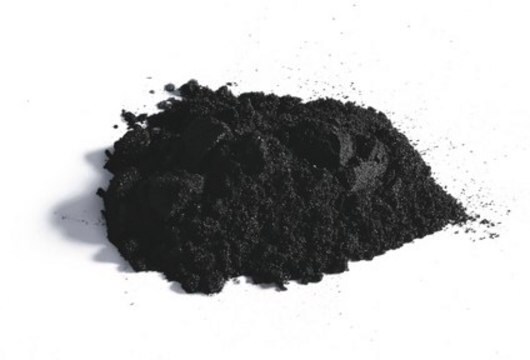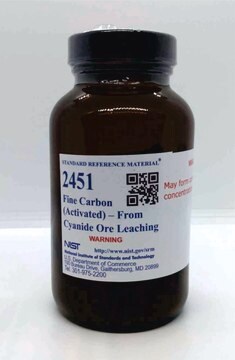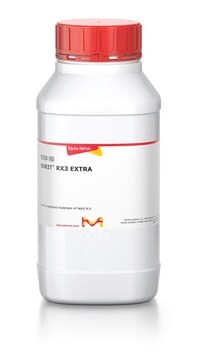1.02514
Charcoal activated
granular about 1.5 mm extra pure
Synonyme(s) :
Charcoal activated
About This Item
Produits recommandés
Niveau de qualité
Forme
granular
Superficie
800-1500 m2/g
Impuretés
cyano compounds (CN), passes test
polycyclic aromates, passes test
tar, passes test
≤5% HNO3 solubles
≤5% Substances soluble in nitric acid
Résidus de calcination
≤10% (600 °C)
Perte
≤10% loss on drying
Taille des particules
1.5 mm
Pf
3550 °C
Masse volumique apparente
150‑440 kg/m3
Traces d'anions
chloride (Cl-): ≤1000 ppm
Traces de cations
As: ≤5 ppm
Fe: ≤500 ppm
Pb: ≤20 ppm
Zn: ≤100 ppm
Température de stockage
no temp limit
InChI
1S/C
Clé InChI
OKTJSMMVPCPJKN-UHFFFAOYSA-N
Application
- Adsorptive Removal of Dyes and Contaminants: Activated charcoal is extensively used for the adsorption and removal of dyes and other contaminants from aqueous solutions. Recent research highlights the use of activated charcoal modified with BaFe12O19 powder for the efficient removal of methyl blue dye. This magnetic adsorbent can be easily retrieved and reused, making it a sustainable option for water purification (Polley and Bera, International Journal of Environmental Analytical Chemistry, 2023).
- Heavy Metal Detection and Removal: Activated charcoal is utilized in composite materials for detecting and removing heavy metals from water. A notable study developed a Ni-sensor based on activated charcoal plastic membranes, showcasing the material′s effectiveness in analytical applications for environmental monitoring and pollution control (Zareh et al., Journal of Analytical Chemistry, 2022).
- Filter Composites for Industrial Wastewater Treatment: Activated charcoal combined with banana rachis cellulose nanocrystals has been used to create filter composites for industrial wastewater treatment. These composites effectively remove dyes and heavy metals, demonstrating their potential for large-scale environmental applications and enhancing water quality (Rahman et al., International Journal of Environmental Analytical Chemistry, 2022).
- Dental Applications: In dental research, activated charcoal combined with calcium hydroxide has been evaluated for its effect on dentin microhardness. This combination shows promise in dental treatments, particularly in enhancing the mechanical properties of dentin and offering potential benefits in restorative dentistry (Abdel Hamid, Egyptian Dental Journal, 2023).
- Environmental Adsorbents and Sensors: Activated charcoal is also used in creating advanced environmental adsorbents and sensors. For instance, a study focused on the development of magnetically retrievable BaFe12O19-activated charcoal-chitosan composite powders for the adsorption of methyl blue dye. These materials offer high efficiency, reusability, and easy recovery, making them ideal for environmental remediation applications (Polley and Bera, International Journal of Environmental Analytical Chemistry, 2022).
Remarque sur l'analyse
Substances soluble in nitric acid: ≤ 5 %
Chloride (Cl): ≤ 1000 ppm
Cyano compounds (CN): passes test
As (Arsenic): ≤ 5 ppm
Fe (Iron): ≤ 500 ppm
Pb (Lead): ≤ 20 ppm
Zn (Zinc): ≤ 100 ppm
Polycyclic aromates: passes test
Tar products: passes test
n-Hexane adsorption: ≥ 30 %
Residue on ignition (600 °C): ≤ 10 %
Loss on drying: ≤ 10 %
Code de la classe de stockage
11 - Combustible Solids
Classe de danger pour l'eau (WGK)
nwg
Certificats d'analyse (COA)
Recherchez un Certificats d'analyse (COA) en saisissant le numéro de lot du produit. Les numéros de lot figurent sur l'étiquette du produit après les mots "Lot" ou "Batch".
Déjà en possession de ce produit ?
Retrouvez la documentation relative aux produits que vous avez récemment achetés dans la Bibliothèque de documents.
Les clients ont également consulté
Notre équipe de scientifiques dispose d'une expérience dans tous les secteurs de la recherche, notamment en sciences de la vie, science des matériaux, synthèse chimique, chromatographie, analyse et dans de nombreux autres domaines..
Contacter notre Service technique




